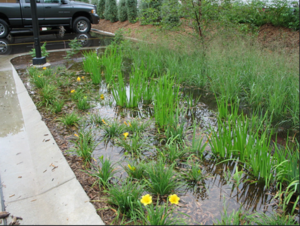
Difference between revisions of "Assessing the performance of infiltration"
m |
m |
||
| Line 1: | Line 1: | ||
| − | + | [[File:Pdf image.png|100px|thumb|alt=pdf image|<font size=3>[https://stormwater.pca.state.mn.us/index.php?title=File:Assessing_the_performance_of_infiltration_-_Minnesota_Stormwater_Manual_May_2022.pdf Download pdf]</font size>]] | |
[[File:Bioretention filled.png|thumb|300px|alt=photo of bioretention with water|<font size=3>A properly functioning bioinfiltration practice should drain within 48 hours of a runoff event</font size>]] | [[File:Bioretention filled.png|thumb|300px|alt=photo of bioretention with water|<font size=3>A properly functioning bioinfiltration practice should drain within 48 hours of a runoff event</font size>]] | ||
Revision as of 18:19, 13 May 2022
Infiltration trenches and infiltration basins are designed to infiltrate runoff and remove pollutants from the surface water stream through attenuation in soil or media or transport into underlying groundwater at concentrations below drinking water standards. It is difficult to assess the performance of these BMPs, although considering only potential impacts to surface waters, a properly functioning infiltration system is considered to be highly performing.
Performance of an infiltration BMP is determined by the length of time needed for captured water to infiltrate. This time is called the drawdown time or period of inundation. The drawdown time is typically 48 hours, meaning water captured by an infiltration BMP should completely infiltrate into the underlying soil or media within 48 hours.
Note: experience has demonstrated that, although the drawdown period is 48 hours, there is often some residual water pooled in the infiltration practice after 48 hours. This residual water may be associated with reduced head, water gathered in depressions within the practice, water trapped by vegetation, and so on. The drawdown period is therefore defined as the time from the high water level in the practice to 1 to 2 inches above the bottom of the facility. This criterion was established to provide the following: wet-dry cycling between rainfall events; unsuitable mosquito breeding habitat; suitable habitat for vegetation; aerobic conditions; and storage for back-to-back precipitation events. This time period has also been called the period of inundation.
An online manual for assessing BMP treatment performance was developed in 2010 by Andrew Erickson, Peter Weiss, and John Gulliver from the University of Minnesota and St. Anthony Falls Hydraulic Laboratory. The manual advises on a four-level process to assess the performance of a Best Management Practice.
- Level 1: Visual Inspection. This includes assessments for infiltration practices and for filtration practices. The website includes links to a downloadable checklist.
- Level 2: Capacity Testing. Level 2 testing can be applied to both infiltration and filtration practices.
- Level 3: Synthetic Runoff Testing for infiltration and filtration practices. Synthetic runoff test results can be used to develop an accurate characterization of pollutant retention or removal, but can be limited by the need for an available water volume and discharge.
- Level 4: Monitoring for infiltration or filtration practices
Level 1 activities do not produce numerical performance data that could be used to obtain a stormwater management credit (stormwater credit). BMP owners and operators who are interested in using data obtained from Levels 2 and 3 should consult with the MPCA or other regulatory agency to determine if the results are appropriate for credit calculations. Level 4, monitoring, is the method most frequently used for assessment of the performance of a BMP.
Use these links to obtain detailed information on the following topics related to BMP performance monitoring:
- Developing an Assessment Program
- Water Budget Measurement
- Sampling Methods
- Analysis of Water and Soils
- Data Analysis for Monitoring
Additional information on designing a monitoring network and performing field monitoring are found at this link.
Related pages
- Overview for infiltration
- Types of infiltration
- Design criteria for infiltration
- Construction specifications for infiltration
- Operation and maintenance of stormwater infiltration practices
- Assessing the performance of infiltration
- Calculating credits for infiltration
- Cost-benefit considerations for infiltration
- Case studies for infiltration
- External resources for infiltration
- References for infiltration
- Requirements, recommendations and information for using infiltration basin/underground infiltration BMPs in the MIDS calculator
- Understanding and interpreting soils and soil boring reports for infiltration BMPs
- Determining soil infiltration rates
- Cold climate considerations for infiltration practices - See [1], [2]

